khatam kari iran
In the city of Isfahan, khatam kari iran first cuts colored wood such as jujube, orange, betel, ebony, etc. in strips with a height of 60 cm to dry. For high quality work, they also use bone, so that First, strips of camel bone are placed in lime water for about 3 months until its color becomes completely white. Wholesale backgammon

In the first stage of cutting, the strips of wood and bone are cut and filed until a clean triangular cross-section is obtained, which is called six in Persian Backgammon Board terms. These strips are placed next to the brass strip, which has become completely similar to wood and bone pieces through ironing, in a colorful and orderly arrangement with a layer of glue

The prepared flowers are tied with thread so that they are firmly stuck together while drying. This process continues until a complete flower with a height of 60 cm is obtained. After preparing several flowers, place them between two boards next to each other. They pick it and fill it with wood glue or seresh and make it in one piece under a press, which is called Qamah

Using a chainsaw, the craftsman cuts layers between one and one and a half millimeters thick from the surface of the face, which is called lange. The dimensions are glued on the work surface by means of special adhesives and by heating.

After puttying, sanding and repairing, the working surface of the inlay is prepared and finally a layer of killer sealer is covered. The finer and stronger the prepared inlay is and if it is made of high quality raw material, the more valuable it is. In some cases, instead of brass, gold and silver are also used. Inlaid objects are sensitive to heat and moisture, and if they are not of good quality, they will rise from the work surface and fall, so to speak, in the vicinity of these elements. Introduction of Isfahan inlay Khatam backgammon board| stages of inlay making

The art of inlaying is one of the traditional and national arts of Iran, whose history goes back to the Ilkhanate era, based on the wooden plaque in the Metropolitan Museum. Using analytical-adaptive methods, the upcoming research investigates the fundamental developments, innovations and innovations of khatam kari iran works of the Safavid and Qajar periods and compares some of the remaining works from these two periods. Introduction of Isfahan Modern backgammon price What is Khatam

Based on the studies conducted in this research, the indicators and components of innovation and creativity in construction techniques and methods were explained in both courses. The results of the studies of this research, while identifying new techniques in design and role, primary materials and materials, similarities, differences and their appearance in the works; Also, their mutual effects are evaluated inlaidwork backgammon and try to identify the national identity of this art. The method of collecting information is library and field. Key words: inlaying, inlaying, Safavid inlaying, Qajar period inlaying, innovation in inlaying

Research background
In the documentary and library review of khatam kari iran art, there are few works, most of them have brief references to the introduction of this art in historical periods. For example, Tahori (1365) in “Khatamsazi Art in Iran” besides a brief definition and a short history of this
art in Iran, has discussed the working method and mentioned some examples. In another book by Rosi Talab and Jalali (2002) in “modern backgammon persian Art”, in addition to mentioning the definitions of this art in cultures and its history, in the field of raw materials and referring to motifs on works

In many encyclopedias and dictionaries, there are definitions of Khatam and Khatam Chess Board and related words, which seem to be not comprehensive and complete definitions in some cases, and after writing them, it is better to add more comprehensive definitions to them. maybe you can

He stated that in none of them, not only a comprehensive definition cannot meet the needs of today’s artist and researcher, but also in the historical discussion, an important period of Qajar inlay art has been mentioned as the period of decline and destruction of this art. Based on the studies of
the author of this essay, there is no significant work in this direction in Persian sources and references

Unlike the previous researches, in this article, in addition to explaining the periods of high and low, and adapting two important periods of this art, independently and with a comprehensive view, it examines all aspects of a khatam kari iran work, such as form, content, innovation, similarities, etc

research method
According to the investigations carried out, it can be said that so far no comprehensive research has been observed on the evaluation and comparison of khatam kari iran of the Safavid and Qajar periods. In general, the articles and writings that are available in this field generally introduce this art and its history, and less attention has been paid to the comparative analysis and description of these two periods as the two most important periods of this art.

This article with a new perspective and with a comparative method and based on an analytical-descriptive approach, referring to library and field sources in the form of direct observation, the samples were first examined and identified, then a complete description was given through their comparison and analysis; The main writing of this article is based on field research and observation and analysis

Definitions
Regarding the meaning and concept of the artist “Khatam Kar” and the art of “Khatam”, we will refer to the definitions in dictionaries and dictionaries
In Dehkhoda’s dictionary, the definition of “Khatam” is given under the definition of “inlaid work” and “khatam kari iran
Khatamsaz. ] (compound noun) the one who places the pieces of bone in the wood with carvings

Khatamsazi [t] (composite hyphen) the act of sealing. Placing pieces of bone with carvings in wood
Khatamkar [T] (compound p.) the one who does Khatamkari. Khatamsaz Someone whose job is Khatamkari
Khatamkari [T] (Compound Hams) placing bones in wood with carvings. Sealing Refer to Khatambandi and Khatamsazi
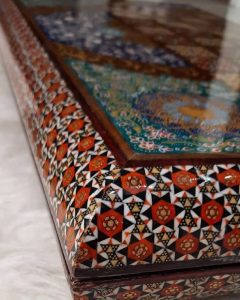
Khatambandi. [tb] (compound comma) act of sealing. Khatamkari. Refer to Khatam and Khatamkari . : Sealing: using ivory, camel bone, etc. to create patterns and flowers on the surface of something; sealing (Moin, 2007) . (496) In the Persian encyclopedia, a definition of “finishing and sealing” is given in this context

The art of decorating the surface of objects, like a mosaic, with small triangles. The various designs of Khatam have always been in the form of
regular geometric shapes. These geometric shapes are made by placing small triangles together. Triangles are made from
various types of wood, metal and bone. The finer and finer the triangles, the better the seal. In a Khatam design, for
Musaheb, at least three triangles are used to make the smallest geometric unit and for the largest one, a maximum of four hundred triangles are used
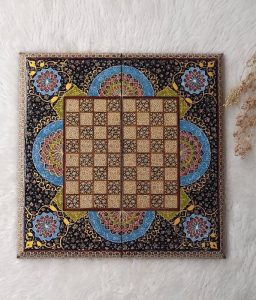
In general, the art of inlaying includes inlaying and inlaying; Perhaps this definition is closer to the original meaning and verb of work than the
rest of the definitions in the mentioned sources
sealing consists of cutting, polishing and filing the raw materials and putting them together based on a geometric design by means of
glue and tying them with thread and finally The formation of Qama Khatam is the final act. The sealer obtains the cut of the seal from the
Qamah and provides it to the sealer

Khatam gluing is the installation of cuts obtained from Qama Khatam on wooden objects with the help of cold glue or hot glue
After the polishing process, Khatam-Gesban sprays a type of protective covering such as polyester on the final effect

History of khatam kari iran
Among the traditional and national arts is the art of inlaying, which, based on the work in the Metropolitan Museum, dates back to the
130s, which can be found in the Metropolitan Museum, khatam kari iran × 41 cm

This work (wooden plaque)
is preserved with inlay and mesh and inlay with the dimensions of New York. Its edges are decorated with very simple wooden inlays (without alloy and bone). The date of construction and the name of the manufacturer are engraved
on this work

The origin of Khatam art is the city of Shiraz, which is still considered one of the most common handicrafts of that city. During the Safavid era, when
Isfahan was chosen as the capital city, artists from all over Iran gathered in this city
Currently, Isfahan is one of the cities
that has the most inlay productions in Iran, although not with the desired quality

The Safavid kings considered the art of inlay as a kind of decorative art and paid attention to it from this point of view. Perhaps for this reason
Rozi Talab and Jalali, 2002) “Khatam art has been largely monopolized by the rich class and in the jirga of aristocratic arts
55). During the reign of Zandiyeh, inlaying was done in the decorations of the tombs of Imams, which was the best proof of the taste and creativity of the artists of this era

Khatamkari works of this period have an unparalleled elegance and mastery, which laid the foundation for innovative methods in the
following periods, including the Qajar period. The Qajar period, unlike the Safavid period, in which the art of inlaying was the exclusive domain of the nobles and the rich, went beyond the
monopoly of the court and found its way into the workshops of ordinary artists

1309 solar year with the construction of a large collection of arts
The beauty of the country in the former Department of Culture and Arts (now renamed as the Traditional Arts Research Institute of the Organization of Cultural Heritage and khatam kari iran
developed and flourished in traditional arts
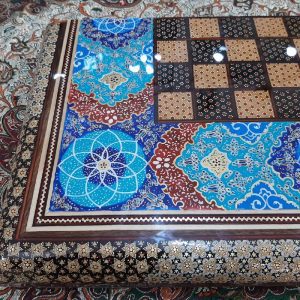
In this regard, the curators of art pursued their goals by establishing workshops
of national and traditional arts, including gold weaving, painting, calligraphy, engraving, enameling, carpets and rugs, etc., to nurture the genius of artists and discover their creativity and create innovative works
The establishment and launch of the Khatam workshop and the

gathering of the most prominent Khatam artists (under the supervision of the late Mohammad Hossein Sani Khatam on the 7th of Shahrivar, 1311
was one of the important events that led to the great national service, prosperity and development of this art

Nowadays, the improvement of inlaying in
the two inlaying halls of the Marble Palace and the inlaying hall of the National Assembly has taken the form of creation by the capable masters of the aforementioned workshop
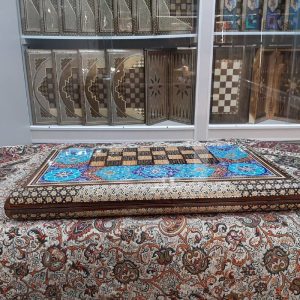
The historical building of Marmar Museum Palace is not only a beautiful and amazing architectural complex, but also a mirror on which the culture and art of contemporary artists of Iran have left an eternal mark. The construction and decoration of this hall was started in 1314
solar year and it was done with the collective efforts of the inlay artists of the traditional arts inlay workshop of the General Department of Fine Arts

khatam kari iran wood
The most used material in sealing is wood; Triangles are prepared from the wood of different trees, such as types of wood with natural colors such as betel, jujube, orange, boxwood, maple, and sycamore, and are used in khatam kari iran-making. In the past, beech wood and ebony were also
used, which were imported from India to Iran along with betel wood, and today all three are rare. In order to compensate for this scarcity and access to the desired color with a variety of colors (red, black, green, etc.), artists usually pour triangles of orange or maple wood
into a metal container containing water and colored substances (natural or chemical) and boil the triangles. Colored wooden triangles can be obtained in the mentioned solution within several hours

khatam kari iran brass alloy
Today, Khatam makers only use brass alloy in making Khatam; Citing a few works from the past, silver-copper and aluminum wires have also been reported. To prepare, at first, the wires (round section) are shaped into triangles by a rolling machine
This device includes two rollers, one at the top and the other at the bottom; Grooves in the form of small and large triangles with different applications are engraved on the lower roller. The upper roller also has a completely smooth surface without grooves, when the wire passes through the
groove on the roller and the movement of its rotating axis, the wire comes out of the device in the form of a triangle

khatam kari iran bones
Usually camel shin bone and leg bone are used, and sometimes due to its unavailability and high cost, cow or horse rib bone (very rare) is used, which does not have the quality of camel bone. The method of preparing bone triangles is that after degreasing, they soak
it in lime water for a few days until the yellowness of the bone disappears and its color turns white. After this operation, the bones are cut into triangular strips as needed

Glue/polyvinyl acetate glue In the past, hot glue (animal glue) was used instead of cold glue (polyvinyl acetate). Handicrafts gram or animal glue used in khatam kari iran is a cartilaginous slimy substance that is obtained directly from parts of the body of animals such as cows and sheep. The way to use it is that before consumption, pieces of sirisham are soaked in water until it becomes completely soft and
pasty, then they are placed in a special double-walled container with indirect heat (water in one and sirisham in the other). Today, cold glue is used for gluing all parts of sealing and sealing. The ease of working with this adhesive
its bonding strength and its good resistance to environmental factors, especially moisture, have made this material the first priority for tilers

khatam kari iran Safavid period inlay art
In this period, the art of inlay, like all arts, had a special importance and was mostly exclusive to nobles and courtiers. Artists in During the Safavid period, they inlaid
the doors of the palaces, the verses of the Qur’an, grave boxes and chairs. The shrine box of Ali Ibn Abi Talib (AS) in Najaf Ashraf is the most delicate masterpiece of inlaying, which was made by a Shirazi master and remained from the Safavid era

Also, parts of the inlaid box of Sheikh Safi’s tomb in Ardabil are Khatam. At that time, Isfahan was the center of seal making, but later when this art started to decline, the city of Shiraz became the only center of seal making industry, and making objects like
backgammon, chess, Qur’an scrolls, and small frames continued. A careful study of the works of this period shows that there were two common methods of making inlays in this period: the first method was
following the previous period (khatam kari iran) in which the inlays were made of square-rectangular and parallel-sided pieces, which limited the color and The variety of raw materials can be clearly seen in it

The second method, which is related to the innovative method of the Safavid period; This method of flower arrangement and
preparation of Qamah Khatam is called, and it is the same method until today. Making single flowers of Khatam with geometrical shapes of five or eight
(Square is also the evolutionary form of making Khatam in this period
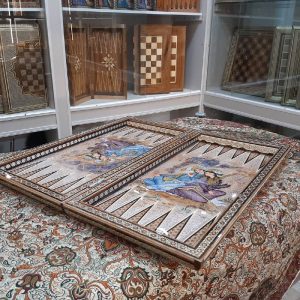
Decoration of blessed places such as shrines and holy tombs, especially the graves of Imams of Athar, became a double motivation for artists and
their passion It doubled for creativity and innovation. It was the emergence of these motivations and the encouragement of the sultans of this period that Iranian artists
Beigi, “started to create lasting and unique works throughout the history of the art of this border and region and left eternal works
